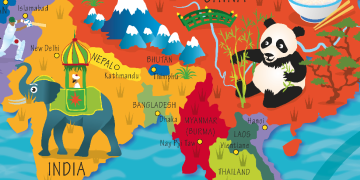Introduction
Asia has entered a new macro-financial era defined by post-pandemic restructuring, persistent inflation pressures, renewed industrial competition, and diverging monetary policy paths. Unlike the synchronized global environment of the 2000s and 2010s—when Asian economies benefited from stable supply chains, predictable inflation, and abundant global liquidity—the 2020s have introduced a radically different set of dynamics.
China is navigating structural transition and disinflation; Japan is exiting decades of deflation; India is becoming the world’s fastest-growing major economy; and Southeast Asia is attempting to maintain stability amid global fragmentation. The region’s financial architecture is being reshaped by supply chain relocation, U.S. monetary tightening, geopolitical tensions, and major demographic shifts.
This article examines Asia’s evolving macro-financial landscape through four key lenses: inflation cycles, interest rate dynamics, post-pandemic recovery patterns, and the growing divergence between major Asian economies. The goal is to present a comprehensive framework for understanding Asia’s financial direction in the 2020s and beyond.
1. Asia’s Inflation Landscape After the Pandemic
1.1 Why Asia’s inflation was initially lower than the West
In 2021–2022, when the U.S. and Europe experienced their highest inflation in decades, Asia remained comparatively stable. Several structural reasons explain this divergence:
- More gradual and targeted fiscal stimulus
Asian governments offered smaller broad-based handouts compared to the U.S., reducing inflationary excess demand. - Different consumption structures
Asian households spend more on food and less on services, moderating the spike in post-lockdown service inflation. - Earlier reopening of factories
Asia restored supply chains faster, preventing the severe goods shortages that fueled Western inflation. - Exchange rate management
Several Asian economies intervened to stabilize currencies, limiting imported inflation.
1.2 The turning point: Imported inflation from commodities
However, the Russia–Ukraine conflict marked a turning point.
- Energy-importing nations like Japan, India, and the Philippines faced rising fuel prices
- Food-importing economies faced grain shortages
- Global shipping costs surged again
By mid-2022, inflation in most Asian economies had risen sharply, though still below Western peaks.
1.3 The new pattern: Persistent yet uneven inflation
The 2023–2025 period revealed a new reality:
- China entered a disinflationary or mild deflationary environment due to real-estate downturn and weak demand.
- Japan finally escaped deflation and saw inflation above 2% for the first time in decades.
- India struggled with volatile food inflation due to climate events and supply constraints.
- ASEAN economies saw moderate inflation but frequent price shocks linked to global supply chains.
Asia’s inflation is no longer synchronized. Each economy now faces its own structural pressures.
2. Interest Rate Divergence Across Asia
The biggest monetary story in Asia since 2022 has been the dramatic divergence in interest rate paths.
2.1 China: The counter-cyclical outlier
While global central banks tightened, the People’s Bank of China (PBOC):
- Cut policy rates
- Reduced RRR multiple times
- Eased mortgage conditions
- Supported local government financing mechanisms
China’s monetary stance reflects its domestic challenges:
- Weak consumption recovery
- Real estate deleveraging
- Slowing investment growth
- Deflationary pressures
The result is a China-independent rate cycle for the first time in 20 years.
2.2 Japan: The historic exit from ultra-loose policy
After maintaining negative interest rates since 2016, the Bank of Japan (BOJ):
- Ended YCC
- Raised rates modestly
- Allowed bond yields to move more freely
The shift was driven by:
- Rising wages
- Persistent inflation above 2%
- A weakening yen
- Pressure from global investors
Japan’s normalization marks the end of a financial regime that shaped global liquidity for decades.
2.3 India: Managing overheating growth
India’s Reserve Bank (RBI):
- Raised rates aggressively in 2022
- Paused in 2023
- Maintained hawkish guidance in 2024–25
Key goals:
- Prevent food inflation spillover
- Maintain currency stability
- Support large-scale infrastructure investment
India’s growth remains strong, but inflation volatility remains its central macro risk.
2.4 ASEAN: Balancing growth and imported inflation
Southeast Asia’s central banks face a delicate balance:
- Higher U.S. rates pressure local currencies
- Growth is slowing in trade-dependent economies
- Tourism recovery supports partial demand rebound
Policy paths vary:
- Indonesia: Proactive rate hikes to defend rupiah
- Thailand: Gradual tightening, later easing to support growth
- Philippines: Aggressive tightening to combat food and fuel inflation
The region remains vulnerable to external shocks.

3. Post-Pandemic Recovery: Asia’s Biggest Divergence in 30 Years
Asia’s recovery patterns since 2020 can be divided into three models.
3.1 The “High-Growth Rebound” Economies (India, Vietnam, Indonesia)
Key traits:
- Strong demographics
- Resilient domestic consumption
- Global supply chain relocations
- Rapid digital transformation
India stands out:
Its economy is on track to become the world’s third-largest by 2030.
3.2 The “Slow-but-Stable” Economies (Japan, Korea, Malaysia)
These economies face:
- Aging populations
- Higher manufacturing costs
- Slowing export competitiveness
But they maintain strong macro fundamentals.
Japan’s inflation resurgence complicates the BOJ’s policy, but GDP growth remains positive.
3.3 The “Structural Adjustment” Economies (China, Thailand)
China is shifting from:
- Property-driven growth → innovation-driven growth
- Investment-heavy model → consumption and services
- Export-led boom → more balanced domestic focus
Thailand faces long-term challenges in competitiveness and tourism dependence.
4. Global Forces Reshaping Asian Financial Conditions
4.1 The U.S. dollar’s dominance and Asian vulnerabilities
Asian economies remain highly sensitive to:
- U.S. rate hiking cycles
- Dollar strength
- Global liquidity shifts
Many Asian crises—from 1997 to 2022—were triggered by tightening dollar liquidity.
4.2 Geopolitical fragmentation
Key pressures:
- U.S.–China tech decoupling
- Realignment of supply chains (“China+1”, “Friendshoring”)
- Trade fragmentation and tariff resurgence
These create financial uncertainty, but also opportunities for India and ASEAN.
4.3 Demographic shifts
Asia is becoming “two worlds”:
- Young, growing economies (India, Indonesia, Philippines)
- Aging, contracting economies (China, Japan, Korea)
This will reshape savings, investment, pension funds, and capital flows.
5. The Future of Asia’s Financial Landscape
5.1 More divergent cycles
Asia will no longer move in a single synchronized business cycle.
China, India, Japan, and ASEAN will follow distinct monetary paths.
5.2 More regional financial autonomy
Expect:
- Asian currency swap lines expansion
- Local currency bond market deepening
- Greater insulation from dollar volatility
5.3 Structural reforms will shape winners and losers
Key factors include:
- Digital infrastructure
- Industrial upgrading
- Energy transition
- Fiscal sustainability
5.4 Asia’s role in global macro policy
Asia will become increasingly central to global GDP growth and financial stability.
Conclusion
Asia’s financial landscape is undergoing its most profound transformation since the 1997 Asian Financial Crisis. Inflation patterns are becoming more complex, interest rate cycles are diverging, geopolitical realignment is reshaping trade, and demographic transitions are altering long-term growth potential.
Understanding Asia today requires moving beyond old models.
It requires recognizing a region defined not by convergence, but by diversity—in policy, growth, risk structures, and financial systems.
Asia’s next decade will not be shaped by uniform expansion.
It will be shaped by asymmetric recovery, fragmented cycles, and strategic repositioning in a multipolar world.
































